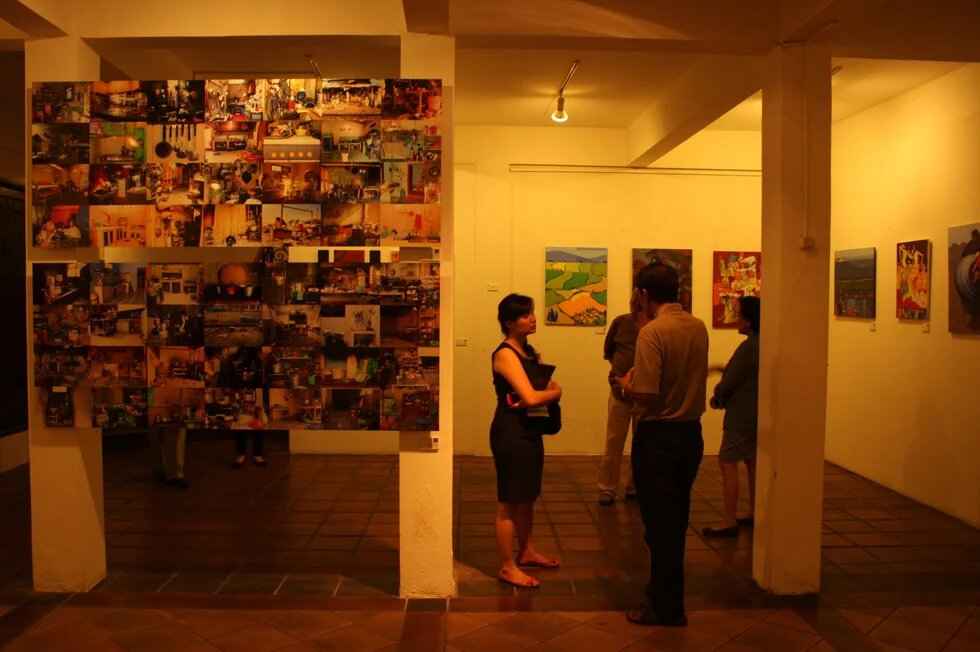
In 2010, six contemporary Indonesian artists ventured to Rangoon, Burma’s largest city, to participate in an international art exchange program. While such exchanges are commonplace among art communities, delving into Burmese expression represented a small milestone. “Ongoing Echoes #1” was the inaugural international art exchange program between Burma and Indonesia. It was designed to boost the development of contemporary Southeast Asian art, as well as to expose the artists of Burma to foreign cultures and artistic expressions.
“Third Wave 2012 Indonesia — Myanmar,” is the third installment of the Ongoing Echoes exchange program, and it will be the first Burmese contemporary art exhibition in Jakarta. The event runs from Thursday until March 1 at Cemera 6 Gallery in Jakarta.“Third Wave” will feature the work of 21 contemporary artists from four leading galleries in Rangoon, in addition to five artists from Malang, East Java. “Ongoing Echoes offered us a special opportunity to travel abroad and take a glimpse of life in a neighboring country, but one isolated from the international community,” said Antonius Kho, an Indonesian artist and event coordinator.
“Prior to the exhibition, the Burmese police assessed all artists’ works, checking if the content and themes were in line with government policy,” he continued. “The event was then given an official certificate of authorization. This is the scenario Burmese artists must regularly face.” Kaung Su, event coordinator and director of Art Rise art-space in Rangoon, said Burma and Indonesia shared similar colonial, cultural and artistic origins. “In [Burma], however, contemporary artists are forced to endure a closed political and economic system. There are limited opportunities to study and learn about contemporary art or come into physical contact with it,” he said.“We need to be exposed to other art and cultural landscapes to build on our creative powers,” he added. Last year, four artists from Burma arrived in Bali for a 10-day visit to participate in the second exchange program “Ongoing Echoes #2.” The artists visited local museums, art galleries and studios, and participated in an exhibition at the Tanah Tho Gallery in Ubud with six Indonesian artists.
“Burmese contemporary art is characterized by a profusion of performance artists whose creativity is unrestricted by their choice and size of media,” Kaung Su said. “Performance art is multidimensional and may be expressed anywhere, at any time, allowing for spontaneity and greater opportunities for the artist to release suppressed emotions.” He said there was a commercial art market within Burma, but that very few avant-garde artists were able to survive off their artwork. The New Zero Art Space in Rangoon, of which Kaung Su is a board member, conceived the idea of an international art exchange program in 2009. With the financial support of the Heinrich Boell Foundation (Southeast Asia) of Germany, international exchange programs have since been established among artists from Singapore, Thailand, Vietnam, Hong Kong, the Philippines, European nations and, in 2010, with Indonesian artists as well.
At this year’s exhibition, Hien Thits of Burma indulges his fascination with the female form. His abstract figure set within a segmented canvas is juxtaposed against scenes from a popular Burmese comic.He focuses on the flowing curves of the torso, which he intentionally exaggerates and accentuates, then brings to life with orange paint. He adds simple yet dynamic calligraphy with brush strokes in black ink to the comic strip, bringing a tension to the overall composition and creating a strong contrast against the controlled visual language of the comic’s narrative.
Kaung Su works from his Blackface Series, which features mixed media on inkjet vinyl and combines acrylic and enamel paint on black and white photographic prints. He applies black spray paint to iconic photographic images, as well as colorful, textured and spontaneous brush strokes to the subject’s upper torso and head, obscuring the figure’s identity. A dramatic aesthetic contrast is created by combining the matte finish of the black and white vinyl image against the raw vibrancy of the paint. These are powerful works exploring our abilities to conceal the darker angels of the human psyche.
Complimenting the “Third Wave” exhibition is the art of photography, which is now being widely embraced by contemporary artists in Indonesia.
Decky Yulian presents his black and white photographic image “Forest,” printed on vinyl. Shot from the floor of the forest and looking up toward the canopy of tree foliage, the image seems to merge and disappear into the natural light. The use of the fish-eye lens increases the sensation of being engulfed by the trees, while the hazy and surreal light highlights the mysterious aura of the forest.
Seto Hari Wibowo frames together 48 color photographic studies of the Indonesian kitchen onto one large 266 x 146 centimeter storyboard. Portraying the most meager of cooking facilities, his printed images represent the kitchens of the majority of his countryman. Our eyes are absorbed in the various shapes, colors and textures within these scenes, which inspire a multitude of personal responses. He intentionally elects not to include images of wealth or luxury.
All artists, in particular those from Burma, need exposure to new cultural and artistic landscapes to be able to develop and build on their creative powers. This third exhibition aims to generate added momentum and opportunities for continued cultural exchange programs between Burma and Indonesia. But given Burma’s tumultuous modern history, it will also raise awareness among Indonesians to the plight of the Burmese people, as well as the creative talents of the country’s artistic community.
-------------------------
This article was originally published on 19 February 2012 on the website of the "Jakarta Globe"
(re-published with kind permission by the "Jakarta Globe")

